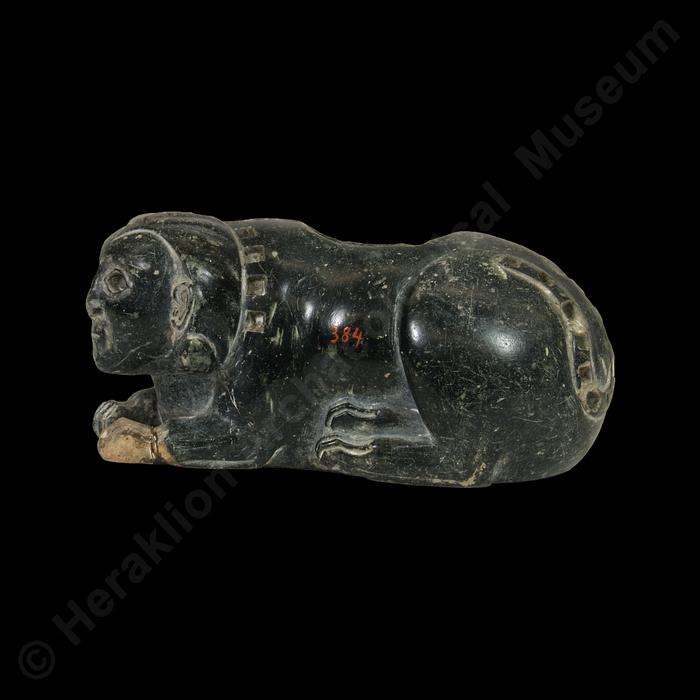Recumbent sphinx utensil
Λ384
Stone (Black steatite)
Good (missing rectangular inlays)
Height: 6.3 cm. Max. Length: 13 cm.
Hagia Triada
Tomba degli Ori
Late Bronze Age. Final Palatial period, Late Minoan ΙΙΙΑ period:
1400 -1300 BC:
Gallery:
XCase:
110Exhibition thematic unit:
Late Bronze Age - Neopalatial period (1700-1450 BC) - Final Palatial period (1450-1300 BC).The cemeteriesGrave goods of the Illustrious dead. Knossos - Archanes - Katsambas and Phaistos area
Description
Utensil in the shape of a recumbent wingless sphinx, a sacred monster with a human head and lion’s body. It has a relatively wide circular cavity in the back, either allowing it to be used as a receptacle or for the placement of a cylindrical element. The object is preserved almost intact: it is missing only the left forepaw, the rectangular inlays of white smalt (as some remaining traces show) that filled the holes in the back and neck, and the eyes originally set in the eye sockets. The head is an extension of the body, without being clearly differentiated from it. The figure has a narrow forehead, almond-shaped eyes, a fine nose and thin lips. The oval face is framed by a hairstyle with a central parting over the brow and a lock of hair on each side, behind the ears (which are carved over the locks). The plump body is arched, while the rear legs are joined together, one behind the other, on one side of the sculpture, indicating the main side of the object. The relief tail curves up in an S-shape on the left haunch. The facial features, the short, stout body, the variety of the inlays and the art of the carved utensil in general are reminiscent of similar works of the Anatolian and North Mesopotamian cultures, which is why it was originally believed to be imported. Today it is thought to be a local imitation of works from the wider East Mediterranean. The cavity in the body is comparable to similar “inkwells” found in Mesopotamia. Alternatively, it may have served to support a cylindrical object, in which case this wingless sphinx was the stone base of a different cult symbol or a token of authority, perhaps a sceptre. This hypothesis is supported by the symbolism of the mythical monster, the protector and guarantor of authority in the civilisations of the Near East.Bibliography:
Paribeni, R. 1904. Ricerche nel sepolcreto di Haghia triada presso Phaestos, Monumenti Antichi, XIV, 749-53, fig. 44, 45. - Pernier, L. & L. Banti 1947. Guida degli scavi italiani in Creta, Roma, p. 38, fig. 52.Author:
D. S.Photographs' metadata
